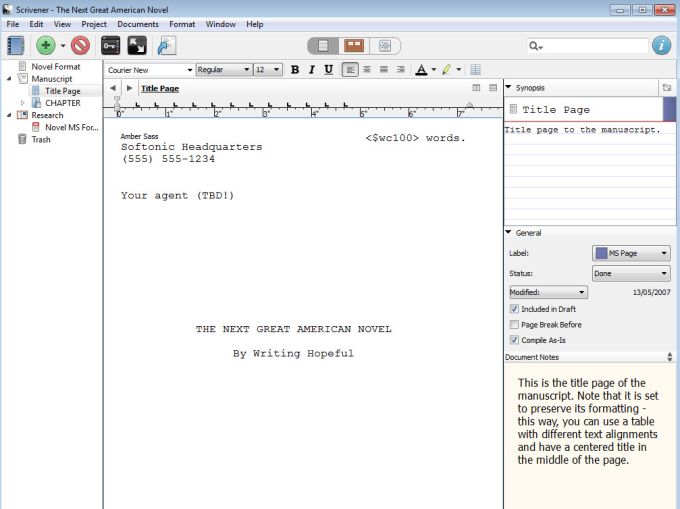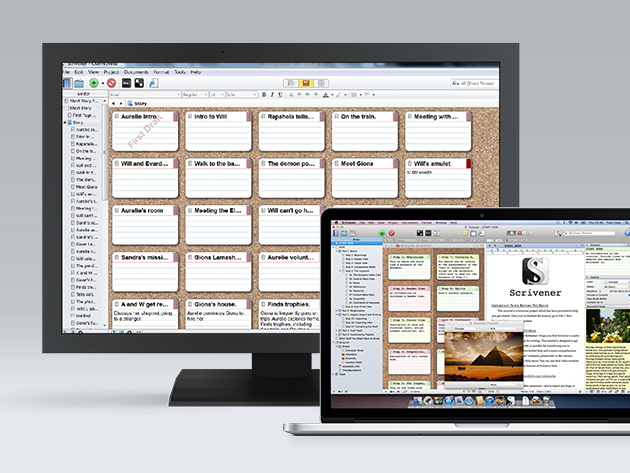

Revise: Use revision marking and the useful Snapshot capability to experiment with and compare the effect of different revision strategies, while still being able to roll back to a previous version.īe mobile: Easily move projects between iOS devices and desktop computers using either an iTunes sync or the Dropbox file sharing service. Also, use Scrivenings view to write one thread of a story all at once in a single view, even if it is broken up in multiple scenes or chapters in the final manuscript.įormat: Optimize the formatting you see when you work in Scrivener for your eyes and your screen, and understand how this can differ from the formatting in a “compiled” version of your manuscript.
SCRIVENER FOR MAC COMPUTER HOW TO
Write: Learn how to hide distractions so you can wordsmith in peace, whether in Full Screen Editing Mode in Windows or the Mac, or Compose Mode on the Mac set up Typewriter Scrolling to keep your writing focus at the center of the screen, not the bottom and view more than one part of your project at once, so you can write in one section while referring to another. Organize ideas by dragging and pinning index cards on the Corkboard.

Use search Collections to search for a character, location, or phrase and see just those texts.Organize your manuscript linearly in the Outliner.Ignore the concept of a traditional file and break your manuscript into sections based on character, theme, topic, scene, or whatever you like.Organize: Use the Outliner, Corkboard, Collections, and Binder to mix and match your content into the perfect final arrangement. Or, you can use the Import and Split feature to import a long document into multiple chapters or segments in Scrivener.īONUS! The ebook has inspirational testimonials about Scrivener from published authors who have embraced Scrivener, including James Fallows, Jason Snell, Jeff Abbott, and Michael Marshall Smith.
SCRIVENER FOR MAC COMPUTER MAC OS X
Beyond importing from the Finder, you can use Mac OS X Services or Scrivener’s handy Scratch Pad panel. And, if you’ve already written bits of text, you can import those items too, including OPML outline files (such as from OmniOutliner Pro). Set up: Add reference materials to your project for easy access - videos, audio files, PDFs, Web resources, and more. You’ll learn how to handle each aspect of the flexible Scrivener manuscript-generation process: The book covers the Mac and Windows desktop versions of Scrivener (screenshots are from a Mac), and it has a special chapter covering key techniques for using the new iOS Scrivener app on your iPad or iPhone. Kirk even explains how to keep yourself on track by switching to Compose Mode and by setting daily progress targets, all on the way to helping you produce a polished, submission-ready manuscript. You’ll learn how to use Scrivener’s Binder, Outliner, and Corkboard to develop characters and settings, collect and organize research materials, and arrange your scenes. Scrivener supports wordsmiths of all types, and it’s designed especially for long-form writing projects - scripts, novels, academic works, and more.Īuthor Kirk McElhearn walks you through using Scrivener to create and manage a writing project. In this book, you’ll take a creative voyage with Scrivener, a unique and popular content-generation tool. IMPORTANT NOTE: This book has been discontinued and superseded by Kirk’s new title, Take Control of Scrivener 3, which covers Scrivener 3 for Mac and Windows, and Scrivener 1.2 for iOS/iPadOS.


 0 kommentar(er)
0 kommentar(er)
